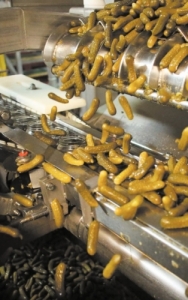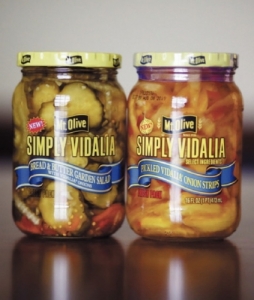A top producer in the county introduces a new product line
By Steve Herring
Published in News on February 13, 2018 5:50 AM

News-Argus/CASEY MOZINGO
Employees of the Mt. Olive Pickle Co. work in the packing plant. The company is expanding and adding several new products to its lineup.

News-Argus/CASEY MOZINGO
Things are falling into place with the Mt. Olive Pickle Co.'s launch of its new "Simply Vidalia" line of products. Shown here is a glimpse inside the pickle company's plant in Mount Olive as pickles fall down into jars traveling down a conveyor belt in the packing area.

News-Argus/CASEY MOZINGO

News-Argus/CASEY MOZINGO
Strips of cucumber are packed into jars to be filled with brine. The strips that do not meet the length and width standards are sent to be turned into relish.
MOUNT OLIVE -- Pickled onions?
"Well, yeah," says Lynn Williams, Mt. Olive Pickle Co. spokesman. "Pickled onions are really, really good. There are just a new addition to our product line along the lines of our Simply Pickles and Simply Peppers.
So we have launched Simply Vidalia.
"There are two versions. There is onion strips, and then there is a bread and butter garden salad so it is a sweet flavor with the Vidalia onions. It has a little bit of carrots and some other things in it."
The company's sweet mix and hot mix had pickled onions. Its Sweet and Hot Salad Peppers and Sweet Salad Peppers also have onions.
"We will see how it eventually does," she said of the new products. "They were introduced within the past year, and it takes a while sometimes for new items to get some feet underneath them.
"But I think the Vidalias are really just an indicator of where we are and where we are headed with our growth. We have been very fortunate, very blessed. We have done a pretty tremendous amount of growing in a very short time."
Also packed for the first time earlier this fall are the new Munchies Bread & Butter and Munchies Kosher Dill products.
These pickles are cut into thicker chunks. So, they are not whole pickles, but they have a much bigger crunch than the standard chip, she said.
When it was founded in 1926 the company sat on 1 acre of land, had a 3,600-square-foot building and packed 6,000 cases during its first year.
In the last three years the company has invested $28 million in new equipment upgrades and warehouse expansions.
"In addition to the warehousing added, we have also continued to do significant upgrades in our plant," Williams said. "This current year we are spending $15 million, and we anticipate another $15 million to $22 million in the next two years.
"Pretty remarkable. Doing well in our business enables us to support our community -- our giving as well as the public events like the New Year's Eve Pickle Drop and the Pickle Festival. In all, we total over $750,000 a year in cash and product contributions."
That includes the company's partnership with the Food Bank of Central & Eastern N.C., as well as cash contributions from the company, the Employees Community Fund and the Mt. Olive Pickle Foundation.
About 170 million jars are shipped out of the plant annually.
"That is a lot of pickles. That is a lot of pickles," Williams said. "We have had good success. As our sales have grown we have had to add space. We added more 300,000 square feet of warehouse space in the past three years."
That includes the former shell building in the Mount Olive Industrial Park, the former Hilex Poly building and former IMPulse building, all located on the Old Mount Olive Highway just north of town.
Also, the company nearly doubled the size of its distribution center, also on the Old Mount Olive Highway, in 2014.
The company now has 1.2 million square feet of warehouse and production space spread over 175 square acres.
"Part of the growth has been fueled in part by the Simply Pickles," Williams said. "We have not been around for 92 years because we don't pay attention. So we realized that our core product line, the traditional line, had the same things in them that they had always had in them."
In the late 1960s, the company was the first food manufacturer in the country to use high fructose corn syrup to sweeten its pickle products.
"We used to tout that," she said. "But we don't anymore because there has been such an uproar about high fructose corn syrup and the role in obesity in the United States. But we followed the scientific community, and it essentially comes down to the same as sugar.
"I don't think you can pin obesity rates on one single, lone ingredient without taking into account how much of it you eat, how much you drink of it in your sodas, exercise levels. It is more complex than a single ingredient."
However, people still have concerns about it, she said.
There are concerns as well about Yellow No. 5, a food color the company has used since the 1960s.
"Some folks have sensitivity to Yellow No. 5, and there are conversations about that," Williams said. "But you really can't pack commercially prepared pickles without color," she said. "Our products have a shelf life, our whole products, have a shelf life of 30 months. If you don't put color in pickles, by the end of their 30 months those are some ugly pickles.
"And no matter what people will tell you they will do, they will not buy ugly pickles. So we kind of looked at all of these things that people have concerns about. So we devised a line of Simply Pickles, what you call a clean label."
High fructose corn syrup has been replaced by sugar in the Simply Pickle line.
The company found a natural color in turmeric to replace Yellow No. 5, she said.
Turmeric has other benefits people appreciate, she said.
It has been used in India for thousands of years as a spice and medicinal herb.
A lot of the preservatives traditionally used are also missing from the Simply Pickles product.
"What we have found is that people are buying these who have never bought commercially packed pickles before," she said. "So it has added a whole new segment of the population to the pickle category. So that has been really exciting to see.
"It is really interesting to follow these consumer trends and see where they are. It really is a millennial thing in some ways. People are paying attention to what they eat, looking at labels, and we appreciate that. So we are trying to make sure that we offer something for those folks."
For the "ultra-tough" consumer, the company has re-introduced an organic product line. The company also offers a line of sugar-free pickles sweetened with Splenda.
Other products include convenience packs such as squeeze relishes for folks to carry for tailgates and similar events.
Sea salt is used in some products since that really appeals to folks who are "foodies" who like to cook, she said.
"The sea salt is just a really nice trend among those folks," Williams said. "That has been very well received. We are one brand, but we have a lot of options for consumers. I think that in part has kind of helped fuel some of our growth."
Mt. Olive Pickle Co. has abut 600 employees year-round and hires another 350 over the summer. Its annual payroll was around $38.4 million in fiscal year 2017.
Green season, when the fresh cukes arrive, used to be six weeks, now it is six months starting in May and winding down in October.
The company earlier brings in 185 million pounds of cucumbers and peppers annually.
A third of the cukes still come from North Carolina. About a quarter comes from outside the U.S. The company pulls in cukes from 10 different states starting in May in Georgia, working up into Midwest and Canada and then back down to Florida, Texas and Mexico in fall and winter.
The tiniest cukes are fermented and shipped in from India.
It also receives products from Greece and Peru.
"We are the No. 1 brand of pickles in the country, which is a big deal," Williams said. "All 50 states. We are about 26 percent of the market. That is something that we are very excited about -- that's in units and dollar sales. That's a big deal for us.
"We are No. 1 or No. 2 in all U.S. regions except California where we are No. 3. So we are working on California. The other thing that is probably important in terms of our growth, we pay attention to consumers. But we also pay attention to our customers who are grocery stores and wholesalers."
In some cases that has meant that the company has made a lot of investment in its plant, she said.
"One of the things that we have been able to offer our customers is that a traditional 12-jar case for our 16 and 24 ounce items -- for some of our slower-moving items, our customers really didn't want 12-jar cases," she said. "It's six-jar cases.
"They wanted a smaller case so they didn't have to hold so much inventory and it would turn over more quickly in their stores. So we have invested in the equipment to do that."
A number of items have been done that way to provide customers with more of what they want, she said.
